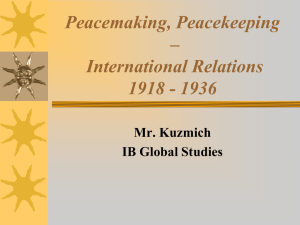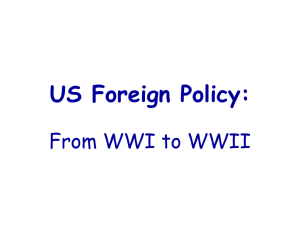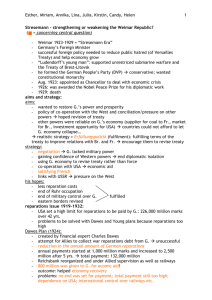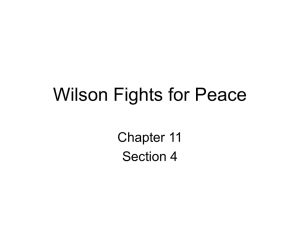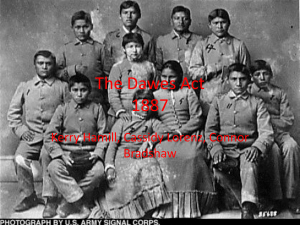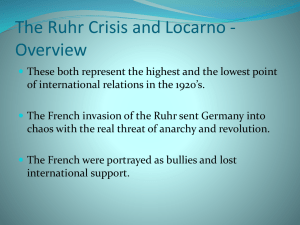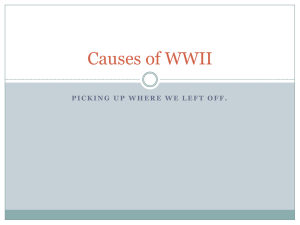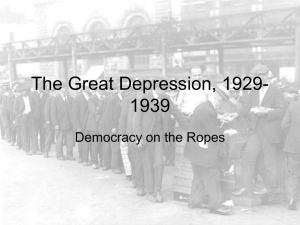File
advertisement
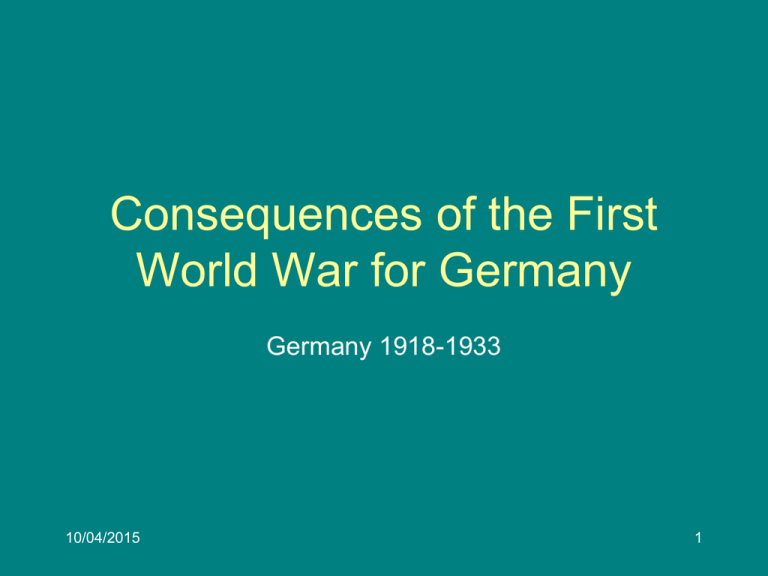
Consequences of the First World War for Germany Germany 1918-1933 10/04/2015 1 The Situation • The Kaiser has abdicated and left Germany. • A power vacuum has been created as there is no established form of government until the Weimar is elected. • Millions of German workers have been killed or seriously injured during the war. • Germany has become an international pariah (outcast) • Germany is subject to an imposed peace settlement 10/04/2015 Germany after the First World War 2 What does this mean in reality? • Political instability. Germany is trying to establish a Republic for the first time. (Weimar Republic) • People kept resigning so they didn’t have to sign the ToV. • New Chancellor elected in 1923– Gustav Stresemann • There are uprisings against the fledging republic even before it is properly formed. • Economic ruin. The war has devastated the economy and further problems occur as a result of the Peace settlement. • Unemployment. Millions of soldiers have returned home to find no jobs available. 10/04/2015 Germany after the First World War 3 The Treaty of Versailles • Terms of the Peace treaty • Massively reduced military capability • ‘War guilt’ clause imposed • Reparations fixed at a very high level • Occupation of the Rhineland • Which leads to… 10/04/2015 Germany after the First World War 4 Problems 1919-1924 • Anger directed at the government for signing the Treaty of Versailles • Economic problems as all profit is sent directly to the Allies as reparations pay-outs • Valueless currency as economic crisis leads to hyper-inflation • Rise of extremist groups attempting to wrestle power from the de-stabilised government – Spartacists (Communists Uprising – Freikorps (paramilitary unit) etc. – Beer Hall Putsch (Hitler) 10/04/2015 Germany after the First World War 5 Treaty of Rapallo 1922 • The only help the Weimar received was the signing of the Treaty of Rapallo between Germany and Russia… • The Treaty of Rapallo was signed in 1922 between Germany and Russia. • It was a recommitment following the Treaty of Brest Litovsk that said both countries would forgive war debts, honor boundaries, and develop cooperation between the two countries. (essentially, they agreed to leave each other alone) Consequences: • While the treaty helped create stability on the Eastern borders of Germany, it also created suspicion for the allies. • The “good will” relationship foreshadowed the alliances that would develop later between Germany, Russia, and Italy. Rhineland Occupation Germany took control of the Rhineland in 1871. The Terms of the Treaty of Versailles stripped Germany of the Rhineland region and created a “demilitarized zone” or buffer between France and Germany. However, German people lived in the Rhineland region, a prosperous industrial region. France occupied the Rhineland as part of the reparations agreement, with a plan to slowly withdraw troops over a 15 year period. The Rhineland region has been a hotly contested region between Germany and France for over a century…. Starting with Napoleon!!! • However, the Germans saw the Rhineland as a huge loss and a “slap in the face to Germany” • Further, Germans in the region refused to submit to French authority. • Riots, strikes, and international tensions spiked in this area and the Germans demanded intervention and compliance. More problems! The Ruhr Crisis • Germany could not pay reparations and spiraled into a severe economic depression. • France and Belgium used this opportunity to seize the Ruhr region (a main industrial region for Germany). France and Belgium said Germany had to pay or give up the land. • The Ruhr Crisis fueled the anger of the German people. • Britain and Germany feared France growing too powerful with the Rhineland and the Ruhr. • Britain did not want a war with France. But they didn’t want to allow France to dominate Germany. They didn’t want Germany and France to spark another war • German’s went on strike, protested, and rioted creating an even worse economic situation with hyper inflation by passively ruining their own economy. • Britain and the United States stepped in and proposed the Dawes Plan … The Dawes Plan of 1924 Gave loans USA Germany War Loans repaid Paid reparations Britain and France Not a perfect solution • France wanted guarantees that Britain and the U.S. would pay what Germany would not if Germany failed to make reparations. • The Germans were upset because the reparations were not lowered and they had to give up control of their railways • The British did not want to police Europe. • The US threatened to quit negotiations if people didn’t work it out. Get on board or go to War • Ultimately, all nations agreed to the Dawes Plan because no one wanted to go to war again. • The Dawes Plan helped Germany begin economic recovery and alleviated tensions throughout Europe. • Is the Dawes Plan a long term solution? • What are some concerns with the Dawes Plan? Locarno Conference • The Locarno conference was from October 5 to October 16, 1925 at Locarno Springs in Switzerland (neutral ground). • The Locarno agreements demanded an end to the bickering. • The agreements solidified the borders of Europe and demilitarized the Rhineland once again. • Each country agreed to allow the League of Nations to intervene if there was a disagreement. • Germany was allowed to become a member of the LoN Locarno Spirit • The sense of peace and the cooperation between the European powers plus the new opportunities for Germany to begin economic recover, led to the idea of the “Locarno Spirit” – true peace in Europe, – goodwill and – concessions to one another for mutual benefit. • Russia is a little bitter about the whole thing. – Left out of agreements, but expected to comply – Anti-Boshevik = would delay international revolution Stability in Europe • The Dawes Plan (1924) is generally accepted as marking the beginning of recovery in Germany in the 1920s and the Locarno Agreements are given credit for solidifying peace. • So, they decided to take it a step further. U.S Participation in Europe: • The Dawes plan and U.S. loans, forced the United States to become more involved in European affairs despite their decision to remain isolationists. • In 1928, Senator Frank Kellogg worked with French Foreign Minister Aristide Briand to create the Kellogg-Briand Peace Pact. • Throughout the 1920’s, the United States slowly saw the value of cooperating with the League of Nations. • Even though they never officially joined the League, the United States participated in peace agreements including the KBPP • After negotiations it was decided that conflicts arising between nations involved in the treaty would resolve their problems through “pacific” means; thus, pacifism is born! Significance of KBPP • The Kellogg-Briand Peace Pact is significant for two reasons: 1.The Kellogg-Briand Peace Pact officially marked U.S. cooperation with the League of Nations. 2.The Peace Pact outlawed war and stated the Pacifism policy. … this is the beginning of appeasement ideas that would be manipulated. Results of the Plans? • Although Germany did appear to begin getting back on it’s feet, it was heavily reliant on foreign loans. Between 1924 and 1930 25.5 billion marks (in loans) flowed into Germany. Real Recovery? • By 1929 industrial production had surpassed its pre-1914 level. • Growing number of large businesses – growing class of industrialists. • Unemployment relatively high by 1929 – not everyone benefited from the ‘Golden Age’. • Agricultural sector not prospering. Weimar by 1929 • The ‘Golden Age’ had seen an explosion of art and literature and many people had enjoyed new freedoms. • The situation for many ordinary Germans seemed considerably better than it had just a few years before. • However the Weimar Republic was still economically and politically vulnerable. Did the economic, political and foreign policy decisions of the ‘Golden AGe’ mAke the Weimar Republic more stable by 1929? The Crash • In many ways, the answer seemed to be yes… • Throughout 1929, it seemed that Europe and America were flourishing… Until October. Wall Street Crash • On October 29, 1929 (Black Tuesday) the Stock Market crashed in the United States triggering the greatest economic depression in history. • Basically: – People were “speculating” on future loans. – Banks called on loans to pay for the international loans. – the U.S. had loaned out too much money to Europe. – Europe was not paying the loans fast enough. – The stocks in investments lost value. • People panicked and tried to get their money from the banks. • The banks didn’t have enough money on hand to give people their money. The Dawes Plan of 1924 Gave loans USA Germany War Loans repaid Paid reparations Britain and France • The banks closed because they couldn’t do business. • No more loans were made to Germany. • The Dawes Plan failed. • Think of dominoes falling… • The dictators used the Depression as their reason for seizing power – (Germany, Russia, Italy, Japan) The system crashed and paved the path to war!
